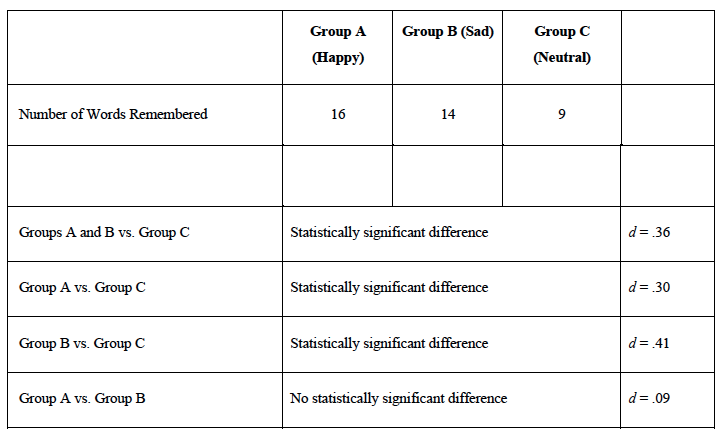step was done to address the study’s( d. construct )validity. Dr. Lonsbary is also considering doing a follow-up study in which instead of asking participants to listen to music to induce mood, she has them write either a story about a character who just won the lottery or a story about a character who just experienced the death of their spouse. This change in the mood variable is designed to enhance the study’s ( a. external )validity. a. external b. statistical c. internal d. construct Answer is D. and A I see the answers but I don't understand how why reporting mood can be construct validity and conducting different tests will be external validity. (please type, no handwriting)
Dr. Lonsbary is a cognitive psychologist who is curious about how mood affects memory. She recruited 60 high school students and divided them into three groups. Group A listened to a 5-minute piece of music intended to make them feel happy (“Happy” by Pharrell). Group B listened to a 5-minute piece of music intended to make them feel sad (a song titled “Home Is Such a Lonely Place” by Blink-182). Group C listened to no music and instead was asked to sit quietly for 5 minutes (thought to make them feel neutral). When a participant would come to her laboratory, Dr. Lonsbary would greet the participant and then ask him or her to roll a six-sided die.
Participants who rolled a 1 or 2 were assigned to Group A. Participants who rolled a 3 or 4 were assigned to Group B. Participants who rolled a 5 or 6 were assigned to Group C. The participants were then given an unlabeled CD to listen to based on their group assignment. The CD contained either the song selection or 5 minutes of silence. They were then escorted into a different room, where they were greeted by a research assistant who conducted the experiment. The research assistant sat the participants in front of a computer screen and told them that a list of 25 words would be displayed on the screen. They were instructed to listen to the CD with headphones while trying to memorize the list of words. All participants were given the same list of 25 common words to remember (e.g., desk, gray, plane, car, mask).
When 5 minutes had passed, the screen displayed a question asking them whether they felt happy, sad, or neutral. After the participant responded, a new screen was displayed asking them to type in all the words they could remember from the list of 25 words. All participants were given 3 minutes to type the words they remembered. Afterward, the participant was thanked and dismissed.
In response to the mood question, a majority of Group A participants said they were happy, a majority of Group B participants said they were sad, and a majority of Group C participants said they were neutral in their mood. Dr. Lonsbary found the following results in response to the number of words remembered.
Dr. Lonsbary’s study asked participants to report on their mood before completing the memory test. Her decision to include this step was done to address the study’s( d. construct )validity. Dr. Lonsbary is also considering doing a follow-up study in which instead of asking participants to listen to music to induce mood, she has them write either a story about a character who just won the lottery or a story about a character who just experienced the death of their spouse. This change in the mood variable is designed to enhance the study’s ( a. external )validity.
a. external b. statistical c. internal d. construct
Answer is D. and A
I see the answers but I don't understand how why reporting mood can be construct validity and conducting different tests will be external validity. (please type, no handwriting)

Trending now
This is a popular solution!
Step by step
Solved in 3 steps









